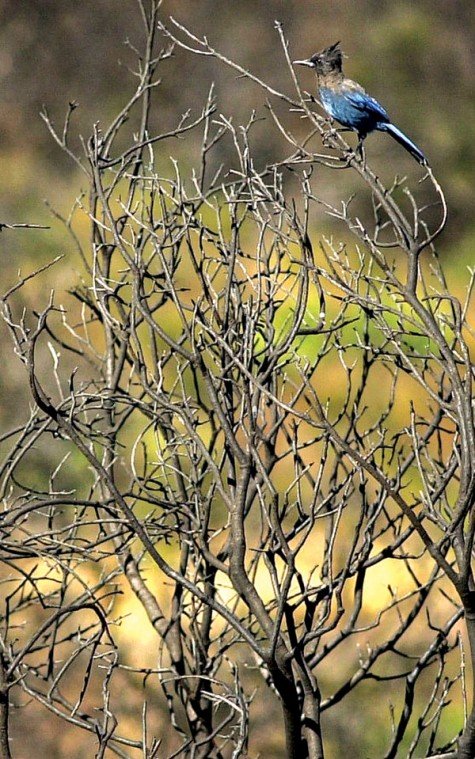GILROY
– Some plants need a flame to reproduce.
Therefore, it makes sense that such flora are bouncing back
nicely in the 3,200 acres torched by the Croy Fire a year ago.
GILROY – Some plants need a flame to reproduce.
Therefore, it makes sense that such flora are bouncing back nicely in the 3,200 acres torched by the Croy Fire a year ago.
“One native plant – the bush poppy – the seeds will only germinate when they’re exposed to fire,” environmental engineer Carol Presley, of the Santa Clara Valley Water District, said Wednesday. “It’s really fascinating. It’s the same with the knobcone pine.”
The highlands west of Morgan Hill and Gilroy, on the eastern side of the Santa Cruz Mountains, are resprouting from last year’s conflagration, which began on Croy Road.
The Croy Fire land is a “chaparral” ecosystem, according to Presley. A chaparral is characterized by infrequent rainfall and fire adaptations in plants.
Presley said she’s recently noticed some new flowers she’s never seen there before. She doesn’t even know their names yet, but there they are, sprouting up from the Croy Fire’s aftermath. Why weren’t they there before? Because the forest hadn’t seen fire in almost 80 years, she said.
“There are some species that absolutely need fire to regenerate,” Presley said.
The regrowth is entirely natural, Presley said. Although she and other water district staff did reseed portions of the ashen soil to prevent mud slides and erosion, they consciously planted sterile grasses with a one-year life span.
“We didn’t want to interfere with the natural process,” Presley said.
Neither the fire, its ash or erosion have ever compromised water quality in the area, Presley confirmed. It’s unknown whether this has been because of the erosion-control efforts Presley mentioned. A year ago, county and federal water officials were concerned that post-fire erosion might harm drinking water, both in the Uvas Reservoir and private wells.
Soil still washes into the Uvas Reservoir during rainstorms, but it did so before the fire as well. Presley said it’s hard to tell if there is more erosion now than before.
Animals that left could return
Many wild animals lost their habitats to the Croy Fire, and there was concern last year that post-fire erosion would affect fish as well by covering spawning grounds and food supplies with silt and ash. Among the fish species native to Uvas Creek is the steelhead trout, protected by the federal Endangered Species Act.
There is little formal information available on how fish and wildlife are doing now in the Croy area. Terry Palmisano, senior wildlife biologist with the state Department of Fish and Game, said budget cuts have gutted her department’s staff and, thereby, the ability to keep on top of many fish habitats.
“We simply don’t have the personnel to do those kind of surveys,” Palmisano said.
In general, Palmisano said, most large animals in the Croy area – such as deer, mountain lions, wild pigs and coyotes – should have been able to escape the blaze. While the short-term loss of habitat might have been harsh, Palmisano said the area may become better in the long run – for deer, at least.
“Deer don’t do very well” in old-growth chaparral like the Croy land, Palmisano said. “It’s like chewing on an old shoe; they don’t like it.”
As new shoots spring up in the scorched chaparral, Palmisano said it’s a matter of a short few years before the landscape is more friendly to deer than it was before.
To thin or not to thin?
The last major burn in the Croy Fire area was in 1923, according to Chris Morgan, a fire prevention specialist with the California Department of Forestry. The growth had become dense over those eight decades; Morgan said he’s seen 20-foot manzanita shrubs with trunks 20 inches thick at the base. When this thick brush was set alight, it burned fast and hot.
Was that forest overdue for an inferno? Morgan said he couldn’t answer.
“You could have an area that hasn’t burned in hundreds of years, but is it overdue? I don’t know.”
On a national level, through the Bush Administration’s Healthy Forests Initiative, trees are being thinned and debris and underbrush removed in national forests to reducing the amount of fuel available to future fires. Critics say fire is a natural process that, over time, makes for healthier forests. Some also say the initiative is a way for Bush to satisfy big timber companies with government contracts.
Morgan said the thinning debate doesn’t apply here, where small trees and shrubs outnumber big trees. Such a question would be more appropriate in the Sierra Nevada Mountain Range. Here, Morgan said, it’s more important for people to clear trees and shrubs from around their homes.
Morgan and other CDF staff are now visiting residents in the Santa Cruz Mountains, inspecting their homes for fire danger and urging people to clear vegetation away from where they live. Not only could this save the house in case of a forest fire, Morgan said, it also could prevent a fire that started in that house from spreading to the forest and other dwellings.
CDF’s goal is to inspect every home in the West Valley highlands by 2005, Morgan said; they’ve hit about 400 so far.
“Any time you leave this valley floor, you have a fairly large potential for having your house catch on fire,” Morgan said.















